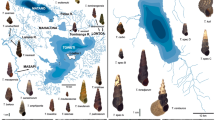Abstract
Slower genetic evolution in microbial thermophiles has been attributed to internal mutation control mechanisms in very high temperatures, whereas the tempo of plant microevolution has been positively correlated to ambient thermal conditions. Here, using a global dataset of 136 teleost fish species, contrasting warm and cool water species, and controlling for any differences between species in mutation control mechanisms, we found mitochondrial genetic evolution was 1.61 times faster in warm water species. These results suggest that temperature-mediated reduction in mutation rate is only important in extreme thermal regimes.

Similar content being viewed by others
References
Adelman R, Saul RL, Ames BN (1988) Oxidative damage to DNA: relation to species metabolic rate and life span. Proc Nat Acad Sci USA 85:2706–2708
Allen A, Gillooly J, Savage V, Brown J (2006) Kinetic effects of temperature on rates of genetic divergence and speciation. Proc Nat Acad Sci USA 103:9130–9135
Bromham L (2002) Molecular clocks in reptiles: life history influences rate of molecular evolution. Mol Biol Evol 19:302–309
Collins MA, Bailey DM, Ruxton GD, Priede IG (2005) Trends in body size across an environmental gradient: a differential response in scavenging and non-scavenging demersal deep-sea fish. Proc Royal Soc B 272:2051–2057
Davies T, Savolainen V, Chase M, Moat J, Barraclough T (2004) Environmental energy and evolutionary rates in flowering plants. Proc Royal Soc Lond B 271:2195–2200
Drake JW (2009) Avoiding dangerous missense: thermophiles display especially low mutation rates. PLOS Genet 5:1–6
Drummond A, Ashton B, Cheung M, Heled J, Kearse M, Moir R, Stones-Havas S, Thierer T, Wilson A (2009) Geneious v4.7. Available from http://www.geneious.com/
Felsenstein J (1981) Evolutionary trees from DNA sequences: a maximum likelihood approach. J Mol Evol 17:368–376
Gillespie JH (2000) Genetic drift in an infinite population: the pseudohitchhiking model. Genetics 155:909–919
Gillman LN, Ross HA, Keeling JD, Wright SD (2009) Latitude, elevation and the tempo of molecular evolution in mammals. Proc Royal Soc B 276:3353–3359
Gillman LN, Keeling DJ, Gardner RC, Wright SD (2010) Faster evolution of highly conserved DNA in tropical plants. J Evol Biol 23:1327–1330
Gillooly JF, Brown JH, West GB, Savage VM, Charnov EL (2001) Effects of size and temperature on metabolic rate. Science 293:2248–2251
Gillooly JF, Allen AP, West GB, Brown JH (2005) The rate of DNA evolution: effects of body size and temperature on the molecular clock. Proc Nat Acad Sci USA 102:140–145
Lanfear R, Thomas JA, Welch JJ, Brey T, Bromham L (2007) Metabolic rate does not calibrate the molecular clock. Proc Nat Acad Sci USA 104:15388–15393
Martin AP, Palumbi SR (1993) Body size, metabolic rate, generation time, and the molecular clock. Proc Nat Acad Sci USA 90:4087–4091
Moranta J, Palmer M, Massuti E, Stefanescu C, Morales-Nin B (2004) Body fish size tendencies within and among species in the deep-sea of the western Mediterranean. Scientia Marina 68:141–152
Ohta T (1992) The nearly neutral theory of molecular evolution. Ann Rev Ecol Syst 23:263–286
Rohde K (1992) Latitudinal gradients in species diversity: the search for the primary cause. Oikos 65:514–527
Sarich VM, Wilson AC (1967) Immunological time scale for hominid evolution. Science 158:1200–1203
Swami M (2009) Turning up the heat. Nat Rev Genet 10:512–513
Swofford D (2002) PAUP*: phylogenetic analysis using parsimony (and other methods) 4.0 beta. Sinauer Associates: CD-ROM, Sunderland, MA
Tamura K, Nei M (1993) Estimation of the number of nucleotide substitutions in the control region of mitochondrial DNA in humans and chimpanzees. Mol Biol Evol 10:512–526
Woolfit M, Bromham L (2005) Population size and molecular evolution on islands. Proc Royal Soc Lond B 272:2277–2282
Wright S, Keeling J, Gillman L (2006) The road from Santa Rosalia: a faster tempo of evolution in tropical climates. Proc Nat Acad Sci USA 103:7718–7722
Wright SD, Gillman LN, Ross HA, Keeling DJ (in press) Energy and the tempo of evolution in amphibians. Global Ecol Biogeogr
Yang Z (2007) PAML 4: phylogenetic analysis by maximum likelihood. Mol Biol Evol 24:1586–1591
Acknowledgments
The study was funded by Nga Pae O Te Maramatanga, Maori Centre of Research Excellence, under the direction of Michael Walker and Linda Smith. S. W. holds the Michael Horton Lectureship in Biogeography at the University of Auckland.
Author information
Authors and Affiliations
Corresponding author
Electronic supplementary material
Below is the link to the electronic supplementary material.
Rights and permissions
About this article
Cite this article
Wright, S.D., Ross, H.A., Jeanette Keeling, D. et al. Thermal energy and the rate of genetic evolution in marine fishes. Evol Ecol 25, 525–530 (2011). https://doi.org/10.1007/s10682-010-9416-z
Received:
Accepted:
Published:
Issue Date:
DOI: https://doi.org/10.1007/s10682-010-9416-z




